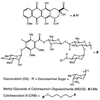Simultaneous determination of helical unwinding angles and intrinsic association constants in ligand-DNA complexes: the interaction between DNA and calichearubicin B
- PMID: 9539736
- PMCID: PMC22488
- DOI: 10.1073/pnas.95.8.4327
Simultaneous determination of helical unwinding angles and intrinsic association constants in ligand-DNA complexes: the interaction between DNA and calichearubicin B
Abstract
We present a helical unwinding assay for reversibly binding DNA ligands that uses closed circular DNA, topoisomerase I (Topo I), and two-dimensional agarose gel electrophoresis. Serially diluted Topo I relaxation reactions at constant DNA/ligand ratio are performed, and the resulting apparent unwinding of the closed circular DNA is used to calculate both ligand unwinding angle (phi) and intrinsic association constant (Ka). Mathematical treatment of apparent unwinding is formally analogous to that of apparent extinction coefficient data for optical binding titrations. Extrapolation to infinite DNA concentration yields the true unwinding angle of a given ligand and its association constant under Topo I relaxation conditions. Thus this assay delivers simultaneous structural and thermodynamic information describing the ligand-DNA complex. The utility of this assay has been demonstrated by using calichearubicin B (CRB), a synthetic hybrid molecule containing the anthraquinone chromophore of (DA) and the carbohydrate domain of calicheamicin gamma1I. The unwinding angle for CRB calculated by this method is -5. 3 +/- 0.5 degrees. Its Ka value is 0.20 x 10(6) M-1. For comparison, the unwinding angles of ethidium bromide and DA have been independently calculated, and the results are in agreement with canonical values for these compounds. Although a stronger binder to selected sites, CRB is a less potent unwinder than its parent compound DA. The assay requires only small amounts of ligand and offers an attractive option for analysis of DNA binding by synthetic and natural compounds.
Figures




Comment in
-
Exploiting circular DNA.Proc Natl Acad Sci U S A. 1998 Apr 14;95(8):4092-3. doi: 10.1073/pnas.95.8.4092. Proc Natl Acad Sci U S A. 1998. PMID: 9539694 Free PMC article. Review. No abstract available.
Similar articles
-
Exploiting circular DNA.Proc Natl Acad Sci U S A. 1998 Apr 14;95(8):4092-3. doi: 10.1073/pnas.95.8.4092. Proc Natl Acad Sci U S A. 1998. PMID: 9539694 Free PMC article. Review. No abstract available.
-
DNA-unwinding test using eukaryotic DNA topoisomerase I.Methods Mol Biol. 2001;95:149-60. doi: 10.1385/1-59259-057-8:149. Methods Mol Biol. 2001. PMID: 11089228 No abstract available.
-
A rapid method for the measurement of the unwinding angle of intercalating agents and the superhelix density of circular DNAs.Nucleic Acids Res. 1978 Jul;5(7):2425-39. doi: 10.1093/nar/5.7.2425. Nucleic Acids Res. 1978. PMID: 209409 Free PMC article.
-
Simultaneous measurement of binding constants and unwinding angles by gel electrophoresis.Methods Enzymol. 2001;340:51-68. doi: 10.1016/s0076-6879(01)40417-4. Methods Enzymol. 2001. PMID: 11494867 No abstract available.
-
The unwinding of circular DNA by intercalating agents as determined by gel electrophoresis.Biosci Rep. 1983 May;3(5):453-60. doi: 10.1007/BF01121956. Biosci Rep. 1983. PMID: 6688368
Cited by
-
Multimerization-cyclization of DNA fragments as a method of conformational analysis.Biophys J. 2000 Nov;79(5):2692-704. doi: 10.1016/S0006-3495(00)76507-6. Biophys J. 2000. PMID: 11053141 Free PMC article.
-
Noncovalent DNA binding drives DNA alkylation by leinamycin: evidence that the Z,E-5-(thiazol-4-yl)-penta-2,4-dienone moiety of the natural product serves as an atypical DNA intercalator.J Am Chem Soc. 2011 Nov 9;133(44):17641-51. doi: 10.1021/ja2046149. Epub 2011 Oct 18. J Am Chem Soc. 2011. PMID: 21954957 Free PMC article.
-
Synapsis of recombination signal sequences located in cis and DNA underwinding in V(D)J recombination.Mol Cell Biol. 2004 Oct;24(19):8727-44. doi: 10.1128/MCB.24.19.8727-8744.2004. Mol Cell Biol. 2004. PMID: 15367690 Free PMC article.
-
Conformational Control of DNA Origami by DNA Oligomers, Intercalators and UV Light.Methods Protoc. 2021 May 22;4(2):38. doi: 10.3390/mps4020038. Methods Protoc. 2021. PMID: 34067324 Free PMC article.
-
Exploiting circular DNA.Proc Natl Acad Sci U S A. 1998 Apr 14;95(8):4092-3. doi: 10.1073/pnas.95.8.4092. Proc Natl Acad Sci U S A. 1998. PMID: 9539694 Free PMC article. Review. No abstract available.
References
-
- Lerman L S. J Mol Biol. 1961;3:18–30. - PubMed
-
- Bates A D, Maxwell A. In: DNA Topology. Rickwood D, Male D, editors. Oxford: Oxford Univ. Press; 1993. pp. 17–61.
-
- Cozzarelli N R, Boles T C, White J H. In: DNA Topology and Its Biological Effects. Cozzarelli N R, Wang W C, editors. Plainview, NY: Cold Spring Harbor Lab. Press; 1990. pp. 139–184.
-
- Wang J C. J Mol Biol. 1969;43:263–272. - PubMed
-
- Bauer W, Vinograd J. J Mol Biol. 1968;33:141–171. - PubMed
Publication types
MeSH terms
Substances
Grants and funding
LinkOut - more resources
Full Text Sources
Research Materials

